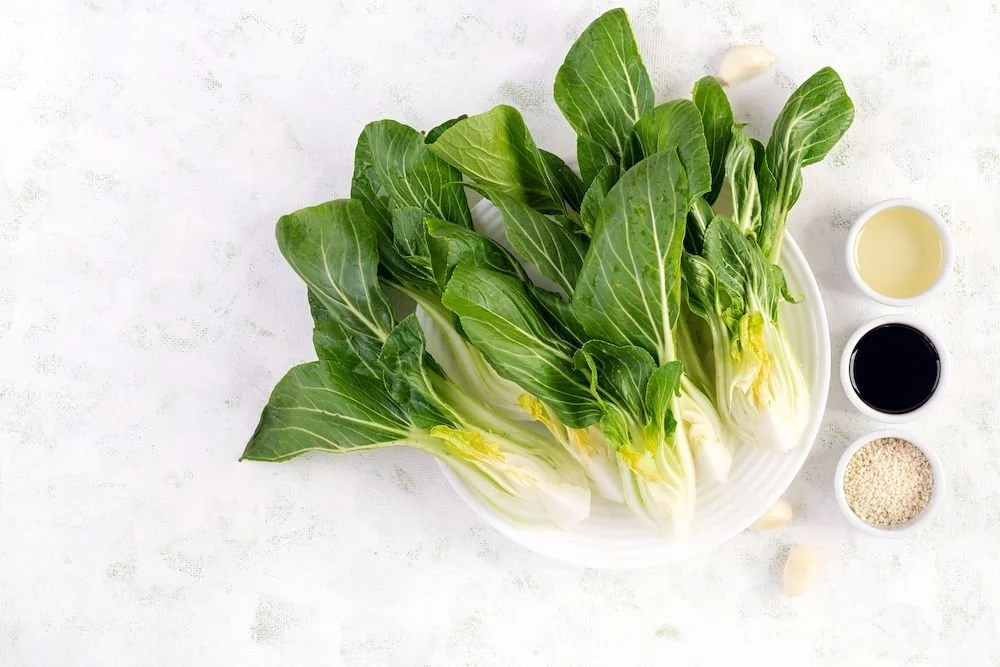Bok choy and baby bok choy are both popular ingredients in stir fries, spring rolls, salads, and more.
Although the two veggies are very similar, they're not exactly the same.
In this blog, we'll break down the differences between regular and baby bok choy so that you feel more at ease handling both varieties.
A Comparison of Bok Choy and Baby Bok Choy
Origins
Bok choy: Originally cultivated thousands of years ago in China, bok choy is one of the oldest Asian vegetables and is still a staple in many dishes.
Baby bok choy: Baby bok choy is not a separate species from regular bok choy, but rather a younger version of the leafy vegetable. It's typically cultivated about 30 days after germination while regular bok choy is cultivated after 50 to 70 days.
Appearance
Bok choy: Regular bok choy is larger in size overall and features broad white stems and dark green leaves.
Baby bok choy: Because it's harvested earlier in its lifespan, baby bok choy has shorter and smaller stalks.
Flavor
Bok choy: The leafy vegetable tastes mild, grassy, and slightly peppery.
Baby bok choy: Baby bok choy is milder and sweeter in flavor than regular bok choy, making it a popular ingredient in salads, grain bowls, and spring rolls.
Texture
Bok choy: The stalks of bok choy are similar in texture to celery, and its leaves are firm and sturdy.
Baby bok choy: Baby bok choy has smaller stems and softer leaves, so it cooks faster than regular bok choy.
Cooking
Bok choy: Due to its large and thick stalks, regular bok choy takes longer to chop and prepare than baby bok choy. The firm stalks, stems, and leaves also take longer to cook.
Baby bok choy: Baby bok choy requires minimal preparation and cooks very quickly.
Uses
Bok choy: Regular bok choy requires a longer cooking time, so it's ideal for stir-fries, soups, or roasting.
Baby bok choy: Baby bok choy cooks quickly, making it perfect for steaming, sauteing, or grilling. Because of its mild and sweet flavor, raw baby bok choy also makes a great addition to salads.
Storage
Bok choy: You can wrap bok choy in a damp kitchen towel or place it in a mesh bag and store it in the refrigerator for five to seven days.
Baby bok choy: Baby bok choy can be stored in the same way, but it may only last three to five days before it starts to wilt.
Nutrition
Bok choy: One cup of bok choy has almost 3 grams of protein, 2 grams of fiber, 600 milligrams of potassium, and 150 milligrams of calcium. It's an incredibly healthy vegetable that can give you a ton of nutrients for very few calories.
Baby bok choy: Because bok choy and baby bok choy are the same plant, baby bok choy's nutritional profile is essentially the same.
5 Bok Choy Recipes You Will Love
1. Garlic Baby Bok Choy
This sauteed baby bok choy with garlic makes a perfect side dish for practically any protein. It's fresh, flavorful, and done in 10 minutes or less.
Cut each stalk of baby bok choy in half.
Cook garlic and shallots over medium-high heat for two minutes.
Add the bok choy, soy sauce, and sesame oil, and cook for another few minutes.
2. Bok Choy Ramen
Ramen is one of the most comforting and versatile meals there is. Bok choy makes a great addition to ramen, especially when paired with garlic and ginger.
For this recipe, you can use either regular bok choy or baby bok choy.
Season and sear chicken thighs, then set them aside.
Add shallots and mushrooms to the pot and cook for about three minutes before adding the broth, spices, and aromatics.
Add the chicken thighs to the soup until fully cooked, then transfer them to a cutting board, chop them up, and put them back in the soup.
Add ramen noodles and bok choy to the soup and cook for a few more minutes.
3. Baby Bok Choy Stir Fry
Stir-frying is one of the most popular ways to enjoy baby bok choy, and this recipe requires only four ingredients and takes about 15 minutes.
Heat peanut oil in a wok over medium-high heat, then add minced garlic.
Add the baby bok choy and continue cooking for one to two more minutes.
Add sugar and soy sauce, reduce to medium heat, and cook for one more minute.
4. Roasted Bok Choy
Roasting bok choy until caramelized gives it a sweet flavor and crisp texture. This quick, easy, and delicious roasted bok choy recipe is a great option if it's your first time cooking with this green leafy vegetable.
Cut the bok choy in half lengthwise and place face-up on a sheet pan.
Mix together garlic, sesame oil, tamari, rice vinegar, maple syrup, and ginger, and brush the mixture over the bok choy.
Roast the bok choy at 400 degrees for 12 minutes, then garnish with sesame seeds and green onions.
5. Salmon Grain Bowl With Bok Choy
Bok choy makes an excellent addition to salads and protein bowls.
This grain bowl recipe combines salmon, avocado, bok choy, and your grain of choice. The result is a nutritionally balanced meal that's packed with protein, whole grains, fiber, and greens.
Mix together a marinade of honey, soy sauce, sesame oil, lime juice, garlic, and ginger, and pour over the salmon.
Bake the salmon for 10 to 15 minutes.
Place your bok choy on a baking sheet, drizzle with oil and soy sauce, and roast for 10 to 15 minutes.
Cook your grains, then combine all the ingredients in a bowl. Top with diced avocado, scallions, and sesame seeds.
Bok Choy and Baby Bok Choy: A Green Dynamic Duo
While bok choy and baby bok choy differ slightly in their appearance, preparation, and flavor, both are highly nutritious and versatile veggies.
If you're not sure which you prefer, try out a few recipes with both!
Hitchcock Farms grows both bok choy and baby bok choy year-round. We're proud to provide sustainable and nutritious foods to our partners.
FAQ
Can I substitute regular bok choy for baby bok choy?
You can substitute regular bok choy for baby bok choy, but keep in mind that regular bok choy takes longer to cook. Also, regular bok choy has a somewhat more bitter and grassy flavor.
What is the best type of bok choy?
All varieties of bok choy have their merits. Regular bok choy is a great staple in soups and stir-fries, and baby bok choy tastes excellent when sauteed or placed in salads.
Can you eat all of baby bok choy?
Yes, all parts of the bok choy plant are edible! The stems take longer to cook than the leaves, though, so you should start cooking them first.






